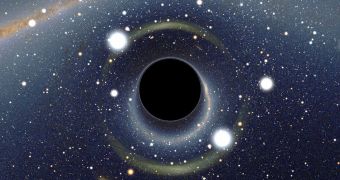Two researchers from the US Department of Energy (DOE) Sandia National Laboratories (SNL) propose that tiny black holes may be capable of creating the gravitational equivalent of atoms. This may be possible as the dense objects begin to capture particles whizzing around them.
Neutral atoms could be captured around such small black holes similarly to how electrons are trapped around an atomic nucleus. Interestingly, the proposal also makes sense in its attempt to explain why these small black holes cannot increase in size and mass.
The phenomenon preventing them from doing so is called quantization, and it also works in the case of electrons and atomic nuclei. The concept had to be developed because, theoretically, electrons should fall towards the center of an atom, not spin around it.
When taking quantization into account, the chance of that happening does not disappear, but rather becomes tremendously small. Similarly, it would be highly unlikely that neutral atoms spinning around a small black hole would ever fall into the object, and thus allow it to grow.
Mini black holes can have masses of 10 to 1000 tones, and astronomers hypothesize that most of them formed when the Big Bang exploded the Universe into existence. This happened approximately 13.75 billion years ago, Technology Review reports.
SNL expert Pace VanDevender and VanDevender say in their new study that it's far more likely these primordial black holes are converted into the gravitational equivalent of atoms, than it is for them to simply whiz out of existence.
Until now, astrophysicists believed that tiny black holes tended to live on until they simply evaporated one day, releasing vast amounts of gamma-rays. However, no study has ever detected such an event.
Though the force of gravity usually has negligible effects at the atomic scale, the primordial black holes should be sufficiently massive to attract particles around them, the two physicists explain.
They add that some of the structures may be so small, that their gravitational pull may be easily counteracted by the thermal energy that particles around them carry. Such black holes may form in the Large Hadron Collider (LHC), but they are completely harmless.
Larger mini black holes should be able to create shells of atoms such as silicon or iron around them, but they still wouldn't be able to grow further. Interestingly, such an object could be detected when it strikes Earth.
The VanDevenders say that the structure would lose its atom shell as it slams into the upper atmosphere, and that this would create radiofrequency (RF) emissions, detectable by specialized instruments and observatories.
“Therefore, a search for electromagnetic signals from gravitational equivalent atoms should focus on fast moving, unidentified RF sources in the space surrounding Earth,” the SNL team concludes.

 14 DAY TRIAL //
14 DAY TRIAL //